Central Illinois
Weather Forecast Office
Overview
|
On Friday, March 14th, an unseasonably strong low pressure system lifted across the Great Plains and into the Midwest. The resulting tight pressure gradient ahead of that cyclone resulted in strong southerly winds that advected an unseasonably warm airmass into the region. In fact, a high temperature record was broken in Peoria and tied in Lincoln and Springfield, hitting 82 and 83 degrees respectively. Preliminary findings from our damage surveys determined there were 8 tornadoes. Two EF-2s and six EF-1s. **Stay tuned for further updates in the coming days** |
 Radar loop from the night of Friday, March 14 into the early morning hours of Saturday, March 15. |
Tornadoes
Select a tornado from the table to zoom into the track and view more information. The default table view is limited to 8 tracks, but can be scrolled by a mouse wheel or dynamically expanded. Additionally, the table can fill the entire window by clicking the small circular expanding arrow icon at the very top right of the table and returned to its original size by clicking the button again. The side information panel that opens over the map can be closed using the "X" on the upper right corner of the pop-up. Zoom into the map and click damage points to see detailed information and pictures from the surveys.
|
NOTE: times shown below are local to your device's time zone. |

The Enhanced Fujita (EF) Scale classifies tornadoes into the following categories:
| EF0 Weak 65-85 mph |
EF1 Moderate 86-110 mph |
EF2 Significant 111-135 mph |
EF3 Severe 136-165 mph |
EF4 Extreme 166-200 mph |
EF5 Catastrophic 200+ mph |
 |
|||||
| Tornadoes that fail to impact any ratable structures on the EF-Scale are rated EF-Unknown (EF-U) | |||||
Storm Reports
Preliminary Local Storm Report...Summary
National Weather Service Lincoln IL
659 PM CDT Mon Mar 17 2025
..TIME... ...EVENT... ...CITY LOCATION... ...LAT.LON...
..DATE... ....MAG.... ..COUNTY LOCATION..ST.. ...SOURCE....
..REMARKS..
0910 PM Tstm Wnd Dmg 3 NE Rushville 40.15N 90.52W
03/14/2025 Schuyler IL Mesonet
Several tree branches were blown down and
power was out for about 6 hours.
0915 PM Tstm Wnd Gst Galesburg Airport 40.94N 90.43W
03/14/2025 M69 MPH Knox IL AWOS
REPORTED AT GBG.
0939 PM Tstm Wnd Dmg Canton 40.56N 90.04W
03/14/2025 Fulton IL Emergency Mngr
Decayed tree split, powerlines down, and
pieces of roofing material blown off a
couple buildings. Timing estimated from
radar.
0940 PM Tstm Wnd Dmg 1 SSE Canton 40.55N 90.03W
03/14/2025 Fulton IL Emergency Mngr
Metal carport blown down. Time estimated
from radar.
0951 PM Tstm Wnd Dmg 4 N West Jersey 41.07N 89.93W
03/14/2025 Stark IL Public
time estimated from radar. Public report of
pieces of metal from farm outbuildings
removed and a small area of a drip edge that
was taken off a home.
0955 PM Tstm Wnd Dmg 4 N Easton 40.30N 89.85W
03/14/2025 Mason IL Emergency Mngr
Structural damage to a home porch.
0957 PM Tstm Wnd Dmg 4 SSW Alta 40.77N 89.66W
03/14/2025 Peoria IL Trained Spotter
Large but decayed tree snapped near the
base. Time estimated by radar.
0957 PM Tstm Wnd Dmg 1 SE West Peoria 40.68N 89.62W
03/14/2025 Peoria IL Broadcast Media
Fence and a few ill-looking trees downed by
thunderstorm winds. Time estimated from
radar.
0958 PM Tstm Wnd Dmg 2 SE Alta 40.80N 89.61W
03/14/2025 Peoria IL Emergency Mngr
A large section of sturdy fencing was
knocked down across from the Kroger on Rt
40.
0958 PM Tstm Wnd Dmg 1 E Peoria Heights 40.74N 89.56W
03/14/2025 Peoria IL Broadcast Media
Rotted tree snapped at its base at the
Peoria Country Club Golf Course. Time
estimated from radar.
0959 PM Tstm Wnd Dmg Pekin 40.57N 89.65W
03/14/2025 Tazewell IL Emergency Mngr
Roofing material ripped off of a large
building. Time estimated from radar.
1000 PM Tstm Wnd Dmg Mossville 40.82N 89.57W
03/14/2025 Peoria IL Broadcast Media
A couple trees downed by thunderstorm winds.
Time estimated from radar.
1000 PM Tstm Wnd Dmg Hanna City 40.69N 89.80W
03/14/2025 Peoria IL Broadcast Media
Restaurant sign blown over. Time estimated
from radar.
1007 PM Tstm Wnd Dmg 3 SE Brimfield 40.81N 89.83W
03/14/2025 Peoria IL Emergency Mngr
Trees down.
1008 PM Tstm Wnd Dmg 1 E Pekin 40.57N 89.63W
03/14/2025 Tazewell IL Emergency Mngr
Tree down. Time estimated from radar.
1010 PM Tstm Wnd Gst New Berlin 39.73N 89.91W
03/14/2025 E70 MPH Sangamon IL Emergency Mngr
60 to 70 mph winds estimated from New Berlin
to Loami.
1015 PM Tstm Wnd Dmg 3 W Green Valley 40.41N 89.69W
03/14/2025 Tazewell IL Public
A grain bin was destroyed and part of a barn
roof was damaged.
1019 PM Hail Athens 39.96N 89.73W
03/14/2025 M0.75 Inch Menard IL Public
Report from mPING: Dime (0.75 in.).
1022 PM Tstm Wnd Gst Chillicothe 40.92N 89.49W
03/14/2025 M61 MPH Peoria IL Emergency Mngr
1025 PM Tstm Wnd Dmg 1 S Washington 40.69N 89.41W
03/14/2025 Tazewell IL Mesonet
Large trees blown down on the south side of
Washington.
1031 PM Tstm Wnd Dmg 2 ENE Beason 40.15N 89.15W
03/14/2025 Logan IL NWS Storm Survey
Siding damage on outbuilding and garage.
1105 PM Hail 3 SE Taylorville 39.52N 89.25W
03/14/2025 M1.50 Inch Christian IL Public
1120 PM Tstm Wnd Dmg Niantic 39.86N 89.17W
03/14/2025 Macon IL Emergency Mngr
Delayed Report. School bus barn roof was
peeled off. Time estimated by radar.
1125 PM Hail Altamont 39.06N 88.75W
03/14/2025 E1.25 Inch Effingham IL Mesonet
1140 PM Tstm Wnd Dmg 3 WNW Findlay 39.54N 88.81W
03/14/2025 Shelby IL Broadcast Media
Barn with 2nd level torn off, near Findlay
along Rt 128. Delayed Report. Time estimated
by radar.
1145 PM Hail 1 E Moccasin 39.15N 88.75W
03/14/2025 M1.75 Inch Effingham IL Mesonet
Hail lasted for approximately 5 minutes and
partially covered the road.
1152 PM Tstm Wnd Dmg 3 ENE Bethany 39.66N 88.69W
03/14/2025 Moultrie IL Public
Farm outbuilding destroyed.
1153 PM Tstm Wnd Dmg Hammond 39.80N 88.59W
03/14/2025 Piatt IL Broadcast Media
Delayed report. Relayed from broadcast
media. Time estimated by radar. Large 12 in
tree limbs down on a house. Shingles peeled
upward on roofing.
1155 PM Funnel Cloud 3 NW Watson 39.06N 88.61W
03/14/2025 Effingham IL Trained Spotter
Corrects previous funnel cloud report from 3
NW Watson.
1155 PM Funnel Cloud 4 NW Watson 39.06N 88.63W
03/14/2025 Effingham IL Trained Spotter
1157 PM Tornado 3 W Lovington 39.72N 88.68W
03/14/2025 Moultrie IL NWS Storm Survey
EF1, peak wind speed 110 mph. Path length
5.1 miles, width 150 yards. Most damage was
to trees and power lines, but farm
outbuildings were destroyed near the
touchdown point, a well as county road 950E
a quarter mile north of 2500N.
1159 PM Tstm Wnd Dmg Hammond 39.80N 88.59W
03/14/2025 Piatt IL Broadcast Media
Gutters and roofing material ripped off of
house, small outbuilding demolished, large
limbs and cell tower blown down. Time
estimated from radar.
1200 AM Tstm Wnd Dmg Neoga 39.32N 88.45W
03/15/2025 Cumberland IL Public
Report from social media. Porch and portion
of roof torn off of home.
1202 AM Tstm Wnd Dmg 1 NE Neoga 39.33N 88.43W
03/15/2025 Cumberland IL Law Enforcement
Semis blown over on I-57.
1203 AM Tornado 1 SE Neoga 39.31N 88.44W
03/15/2025 Cumberland IL NWS Storm Survey
*** 2 INJ ***
EF2, peak wind speed 120 mph. Path length
11.3 miles, max width 300 yards. Touched
down on the southeast side of Neoga, and
damaged the roof of the high school and
caved in the front door of the elementary
school. Two injuries occurred in semis that
were overturned on I-57 at the US-45 exit.
The tornado tracked northeast and crossed
into Coles County west of US-45, lifting
along Lerna Rd. south of county road 450N.
1205 AM Tornado Hammond 39.79N 88.59W
03/15/2025 Piatt IL NWS Storm Survey
EF2, peak wind speed 115 mph. Path length
10.1 miles, max width 150 yards. Numerous
trees were damaged in Hammond, some of which
caused building damage as they fell. The
peak intensity occurred near the
intersection of Don Ryan St. and county road
100, where an outbuilding was completely
destroyed, though high winds also blew down
a cell tower about 3/4 mile east.
1210 AM Tornado 3 SSE Cooks Mill 39.53N 88.38W
03/15/2025 Coles IL NWS Storm Survey
EF1, peak wind speed 100 mph. Path length
0.6 miles, max width 75 yards. Snapped 11
power poles near the intersection of county
roads 500E and 1100N.
1213 AM Tstm Wnd Dmg Janesville 39.37N 88.24W
03/15/2025 Coles IL Public
time estimated from radar. Public photos
shared of large tree branches broken and a
small outbuilding shifted from the
foundation.
1215 AM Tstm Wnd Dmg 1 WNW Lerna 39.42N 88.31W
03/15/2025 Coles IL Emergency Mngr
power lines down. Time estimated from radar.
1220 AM Tstm Wnd Dmg 1 SE Charleston 39.47N 88.15W
03/15/2025 Coles IL Emergency Mngr
power poles and lines down. Time estimated
from radar.
1227 AM Tstm Wnd Gst Tolono 39.99N 88.26W
03/15/2025 M55 MPH Champaign IL Fire Dept/Rescue
relayed via emergency manager.
1231 AM Tstm Wnd Dmg 3 N Mattoon 39.53N 88.37W
03/15/2025 Coles IL Emergency Mngr
power poles broken and powerlines down.
1232 AM Tstm Wnd Gst Willard Airport 40.04N 88.28W
03/15/2025 M64 MPH Champaign IL ASOS
REPORTED AT CMI.
1240 AM Tstm Wnd Dmg Champaign 40.12N 88.26W
03/15/2025 Champaign IL Mesonet
A tree was blown down near the intersection
of S McKinley Avenue and W Church Street.
1241 AM Tornado 6 SE Thomasboro 40.18N 88.11W
03/15/2025 Champaign IL NWS Storm Survey
EF1, peak wind speed 100 mph. Path length
13.5 miles, max width 150 yards. Touched
down just west of Sellars, mainly doing tree
damage. Outbuilding damage occurred along
county road 2000E just north of 2300N, with
additional outbuildings damaged along 2600N
west of 2100E. It continued north-northeast
and went across the northwest edge of
Gifford, causing shingle damage to several
houses. It lifted in the Middle Fork Forest
Preserve near county road 3300N.
1242 AM Tstm Wnd Dmg 4 NNW Clarksville 39.51N 87.83W
03/15/2025 Edgar IL Public
time estimated from radar. image shared of
an open-air farm outbuilding with walls
collapsed and roofing blown off.
1250 AM Tstm Wnd Dmg 1 S Paris 39.60N 87.69W
03/15/2025 Edgar IL Broadcast Media
Trees uprooted, structural damage to a
trailer home, and a roof uplifted from a
single residence home.
1250 AM Tornado 2 SSW Paris 39.58N 87.71W
03/15/2025 Edgar IL NWS Storm Survey
EF1, peak wind speed 90 miles. Path length
3.6 miles, max width 1/4 mile. Touched down
near the intersection of E. 750th Rd. and N.
1400th St. It moved northeast across the
southern part of Paris, damaging several
homes, mobile homes, and trees. It
dissipated on the north side of Sycamore
Hills Country Club.
1251 AM Tstm Wnd Dmg 1 SSE Paris 39.60N 87.68W
03/15/2025 Edgar IL Public
Delayed report. Relayed from social media.
Time estimated by radar. Multiple power
poles down east side of Paris along US 150.
1258 AM Tstm Wnd Dmg Gifford 40.31N 88.02W
03/15/2025 Champaign IL Emergency Mngr
a few trailers flipped.
0153 AM Funnel Cloud Annapolis 39.15N 87.82W
03/15/2025 Crawford IL Trained Spotter
0216 AM Hail 2 SW Bridgeport 38.69N 87.78W
03/15/2025 M0.75 Inch Lawrence IL Public
Report from mPING: Dime (0.75 in.).
&&
$$
Environment
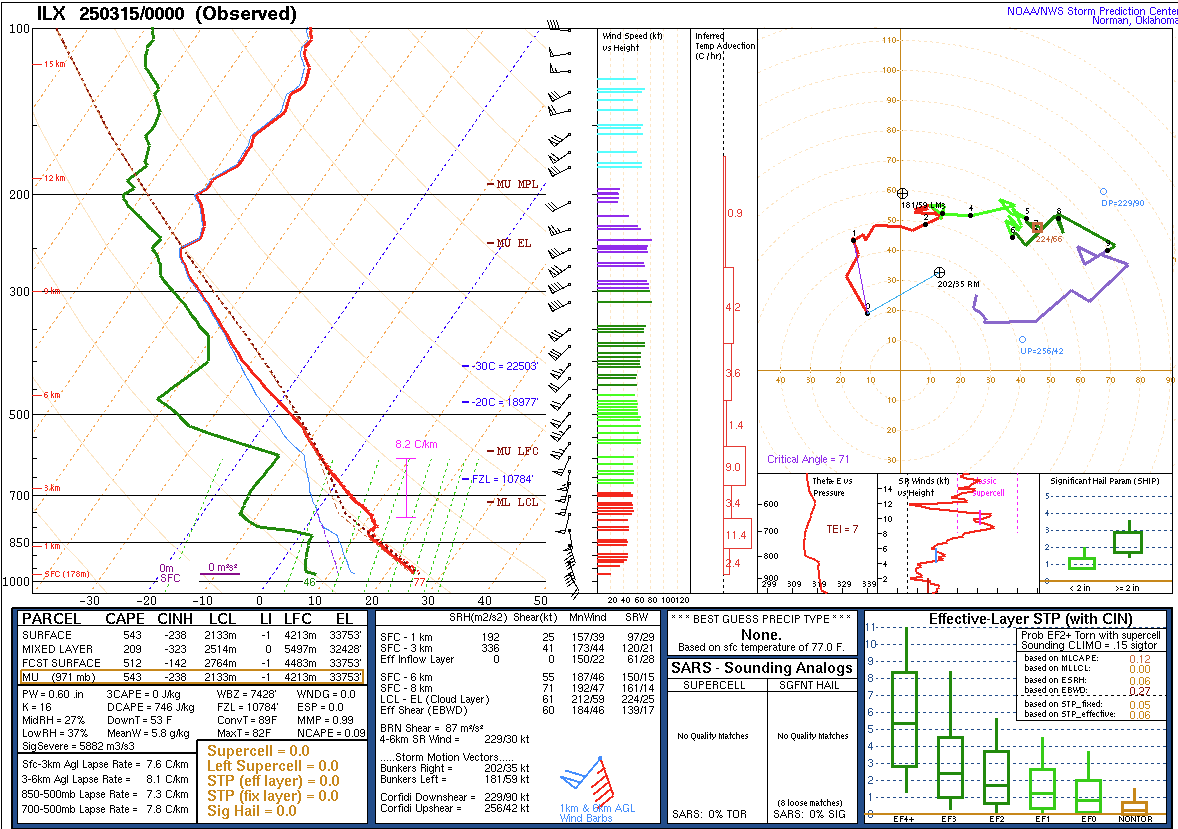 |
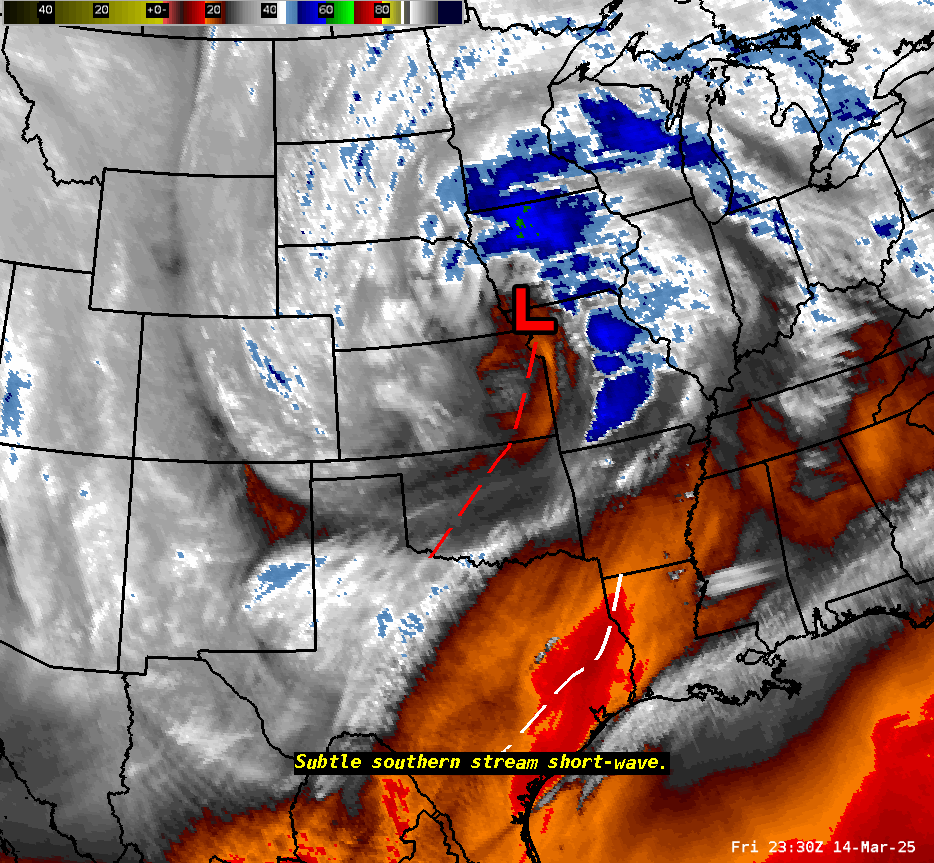 |
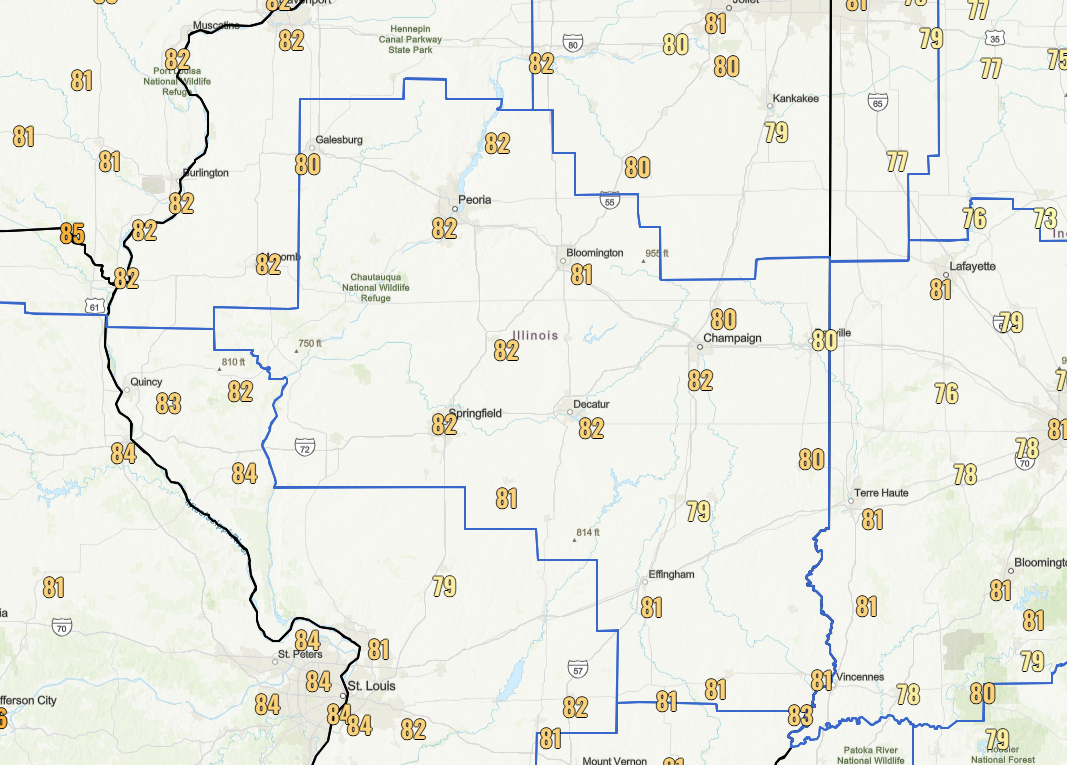 |
| The KILX sounding from the evening of March 14 (00Z March 15). | Infrared satellite imagery showing the powerhouse low pressure system as it pushed storms toward IL late Friday evening (March 14). | Max Temperatures on Fri, Mar 14 were about 30 degrees warmer than normal, which helped aid the environment for severe storm development later that night. |
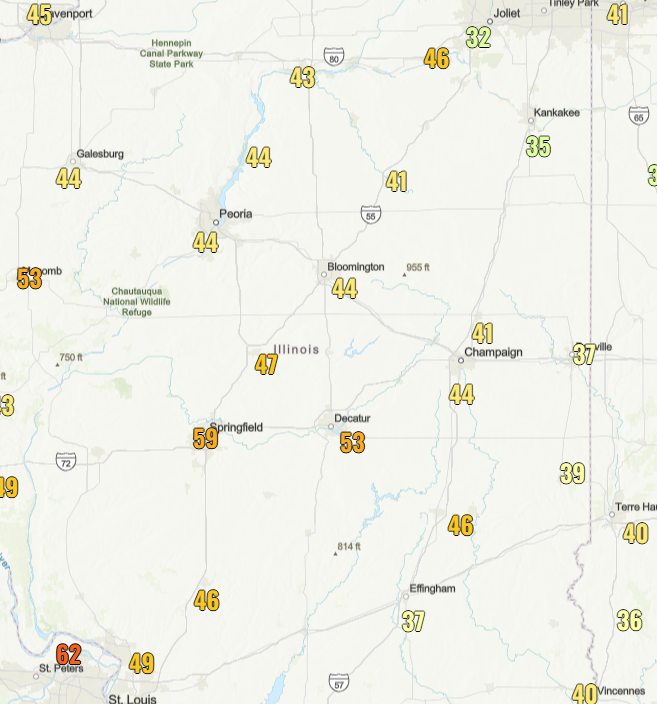 |
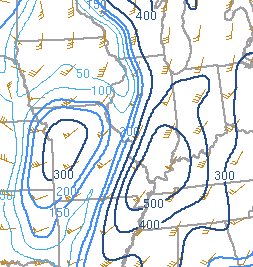 |
|
| Maximum wind gusts across central IL ahead of the thunderstorms Friday evening | 0-1km storm relative helicity (SRH) at 11pm Friday evening. For reference, 0-1km SRH values over 100 m^2/s^2 are favorable for tornadoes. | Figure 6: Caption |
Photos & Video
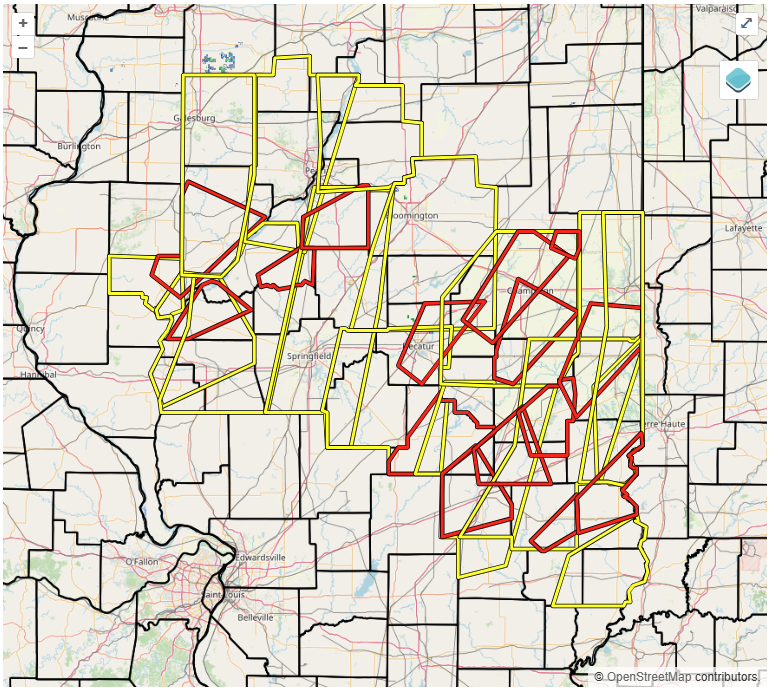 |
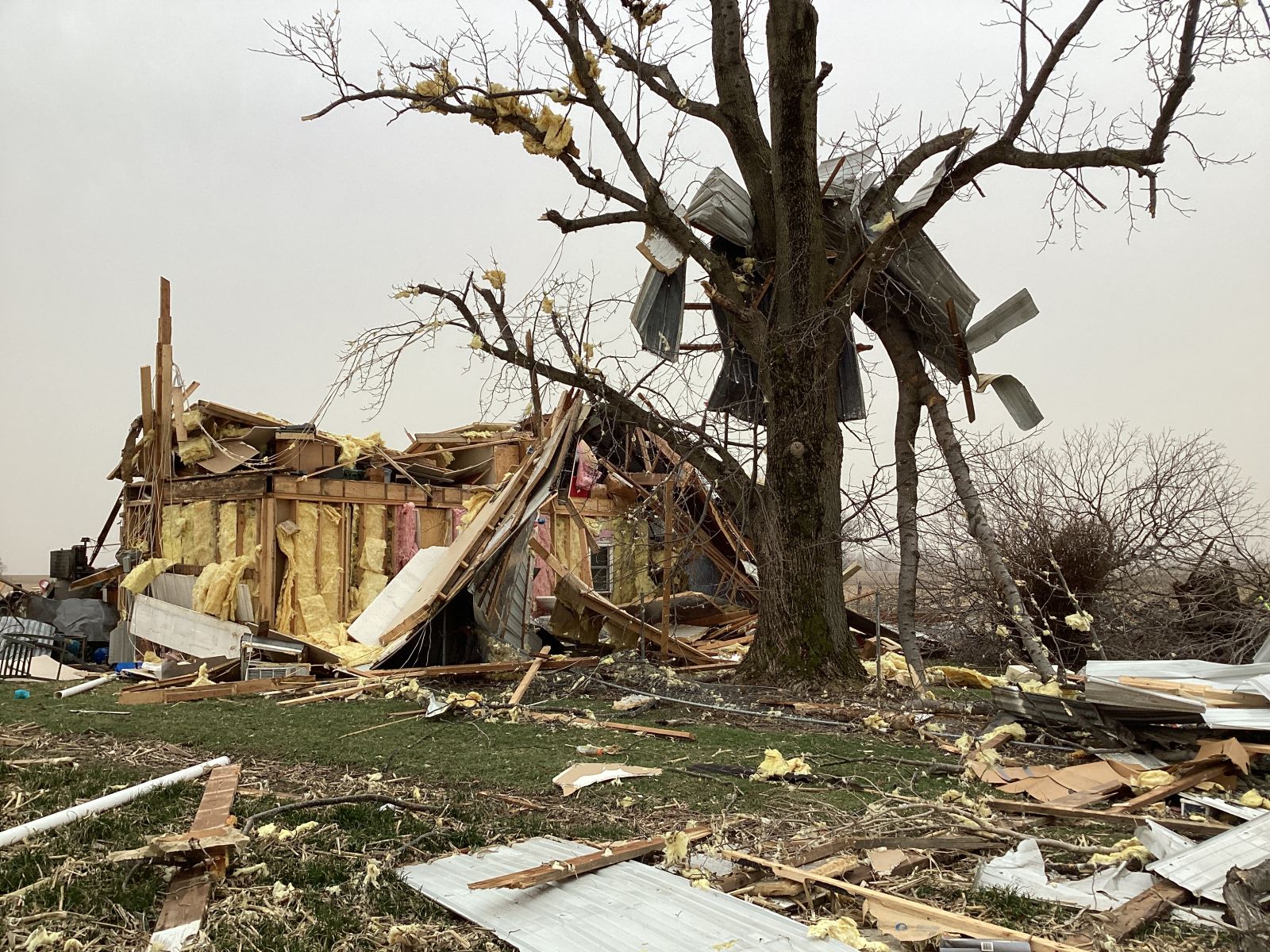 |
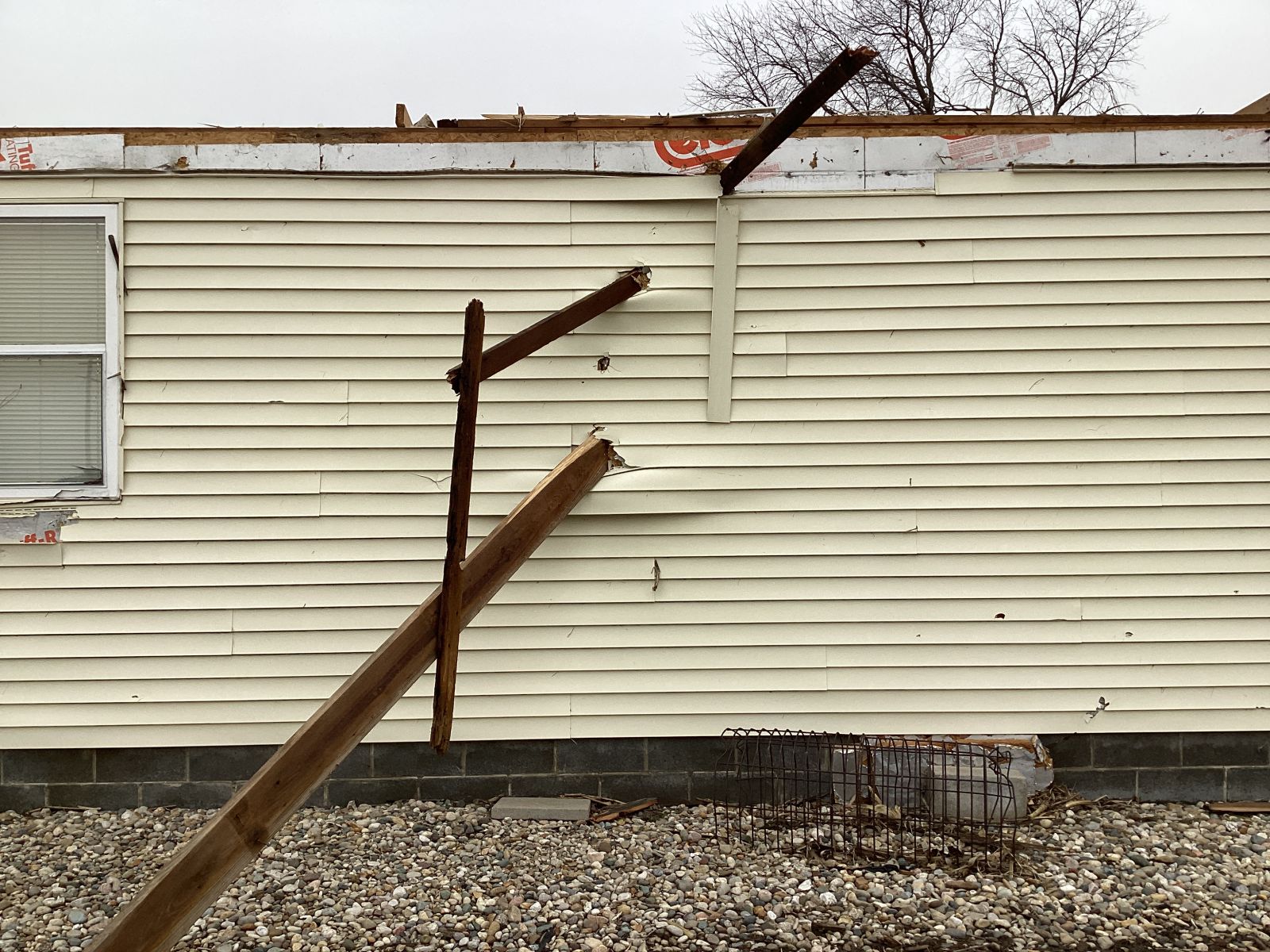 |
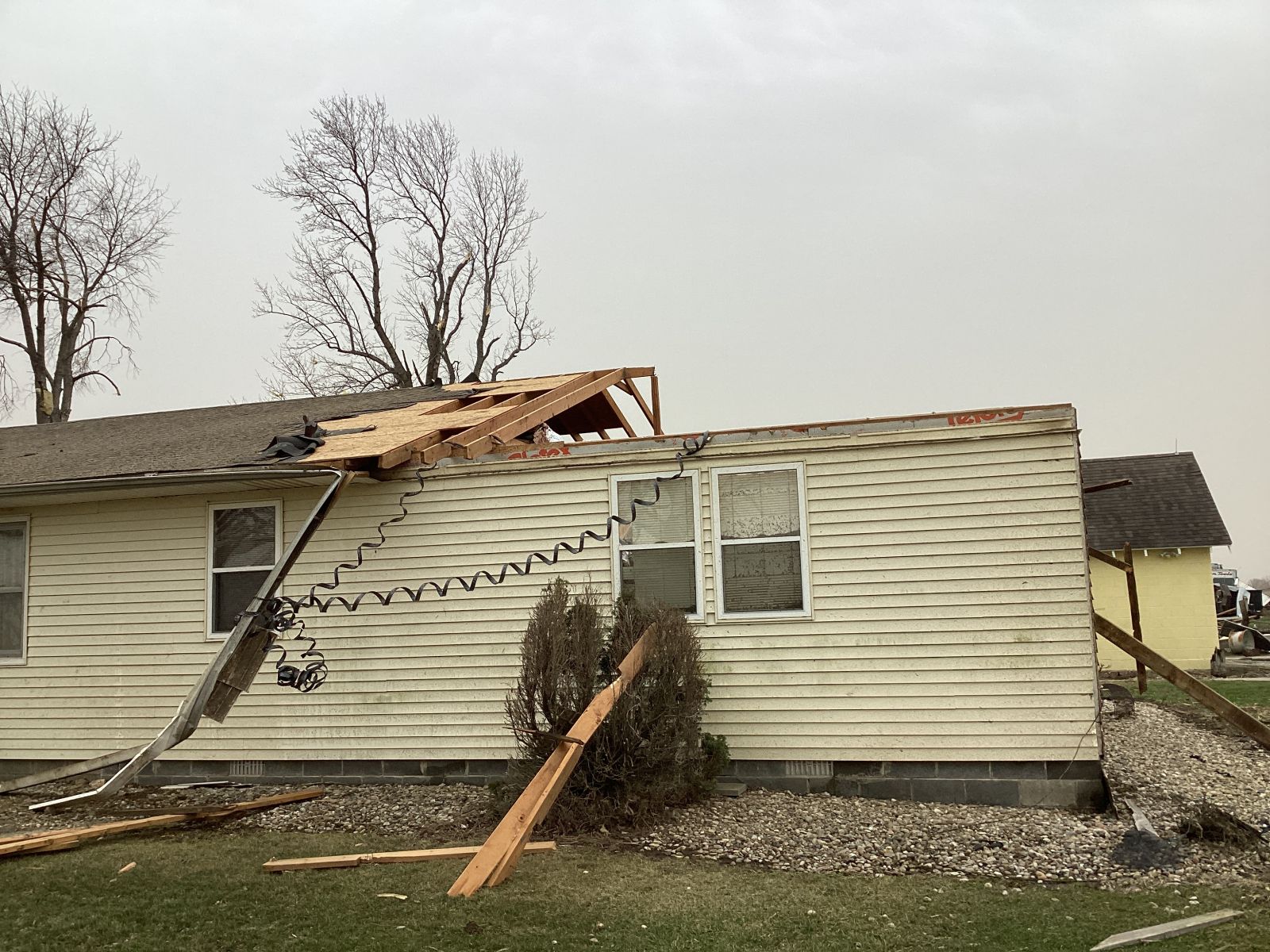 |
| A composite of all the warnings issued by NWS Central IL between March 14-15, which included 16 Severe Thunderstorm Warnings and 15 Tornado Warnings. Image courtesy of Iowa State Mesonet. | Photo of a destroyed outbuilding between Etna and Trilla, caused by the EF2 tornado that began near Neoga. (NWS Survey) | Pieces of plywood impaled into a home on the Cumberland/Coles County line from the EF2 Neoga tornado. (NWS Survey) | Roof damage to a home on the Cumberland/Coles County line from the EF2 Neoga tornado. (NWS Survey) |
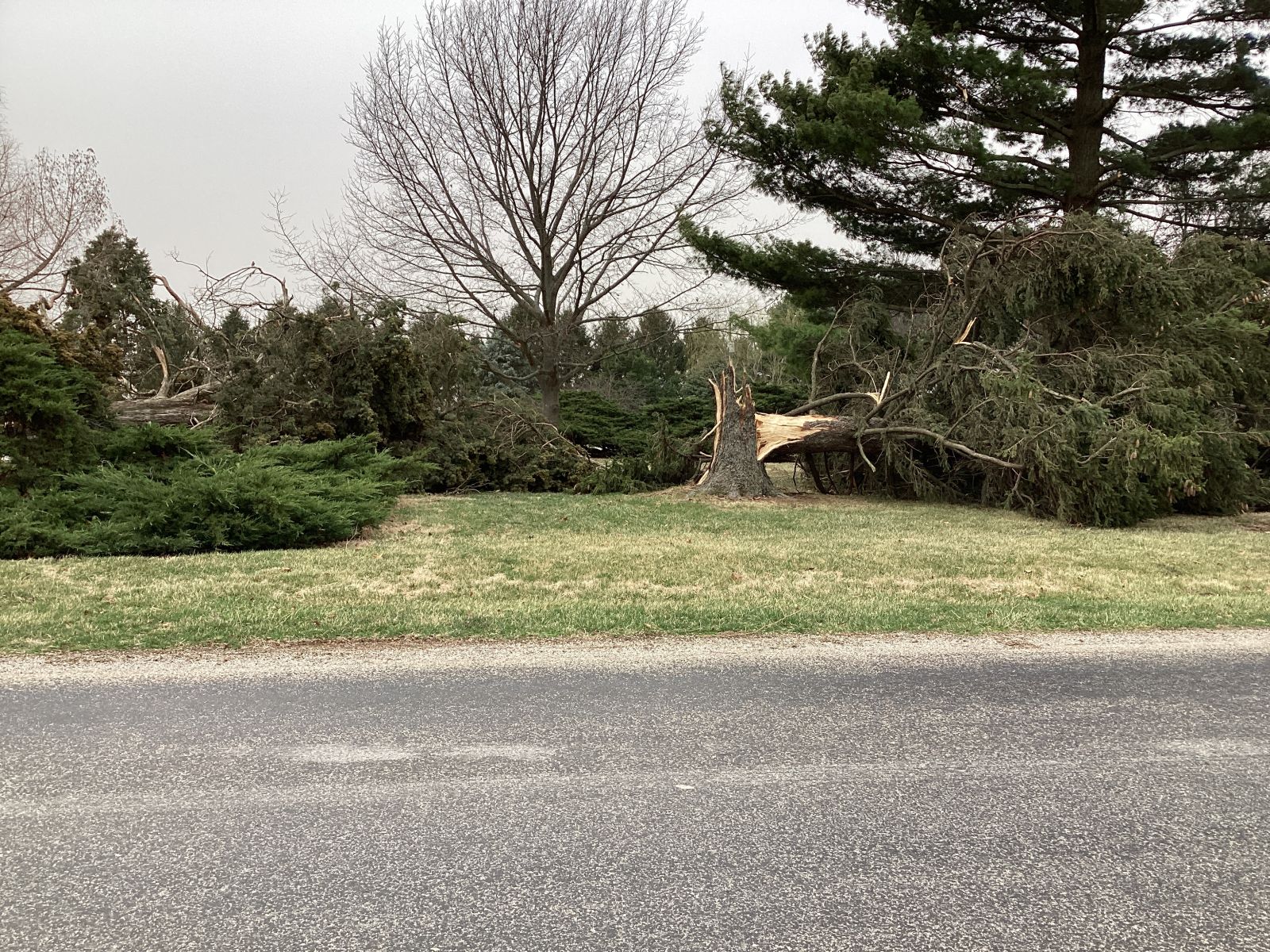 |
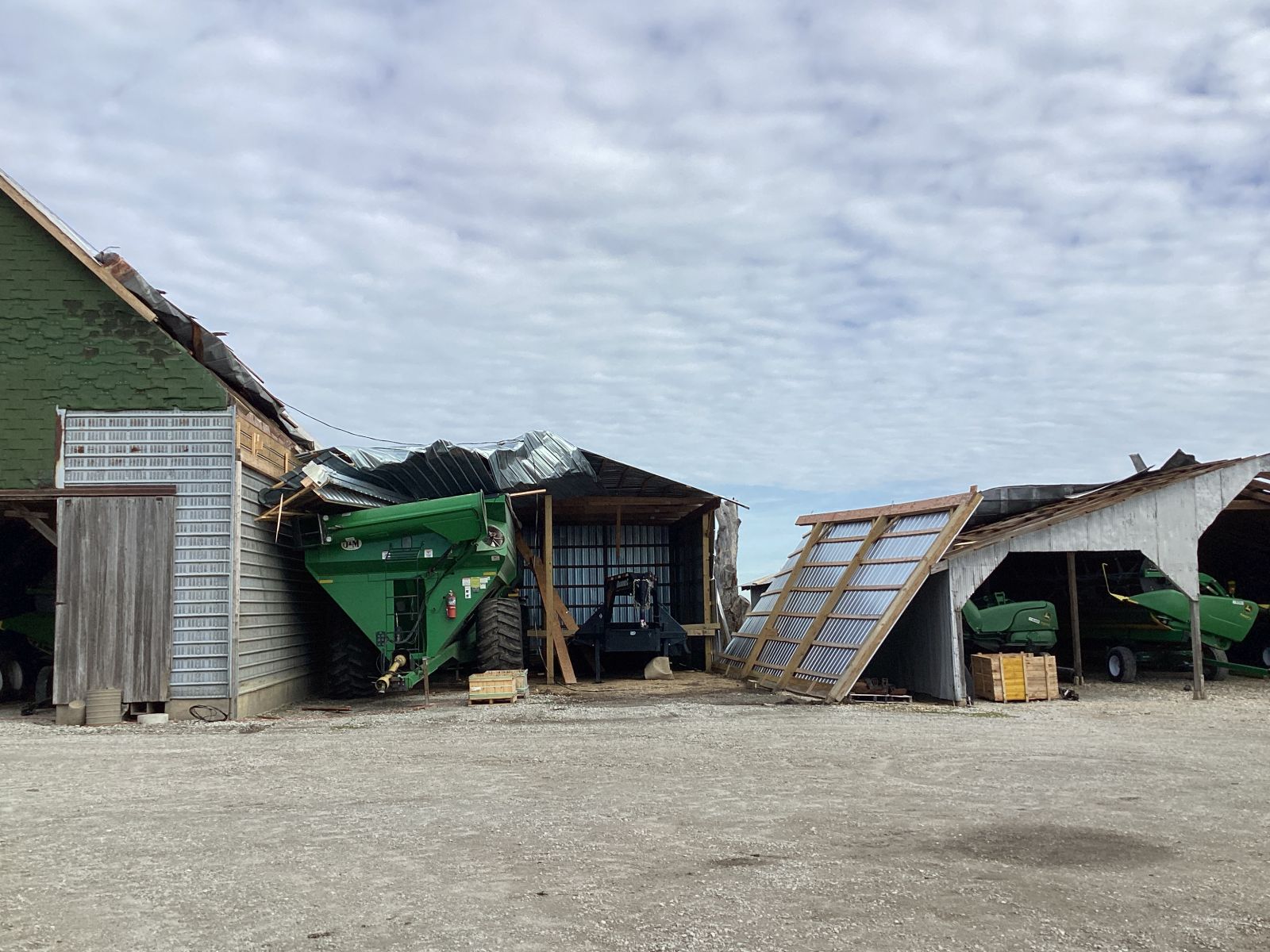 |
||
| Softwood tree trunks snapped along the path of the EF1 tornado about 3 miles north of Mattoon, IL. (NWS Survey) | Damage to a farm outbuilding about 1 mile southeast of Voorhies, IL along the track of the EF2 Hammond, IL tornado. (NWS Survey) |
Caption (source) |
Caption (source) |
Radar
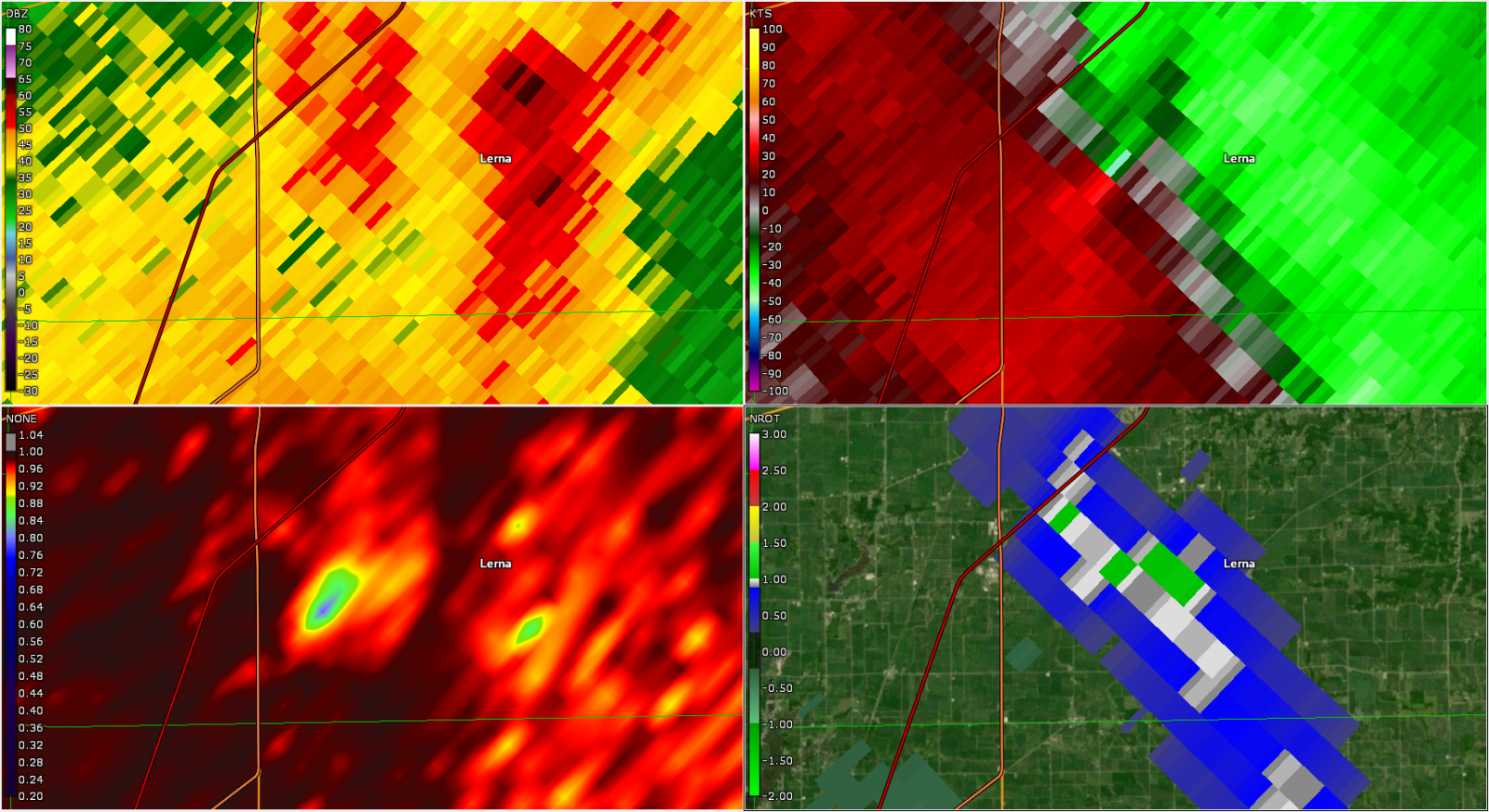 |
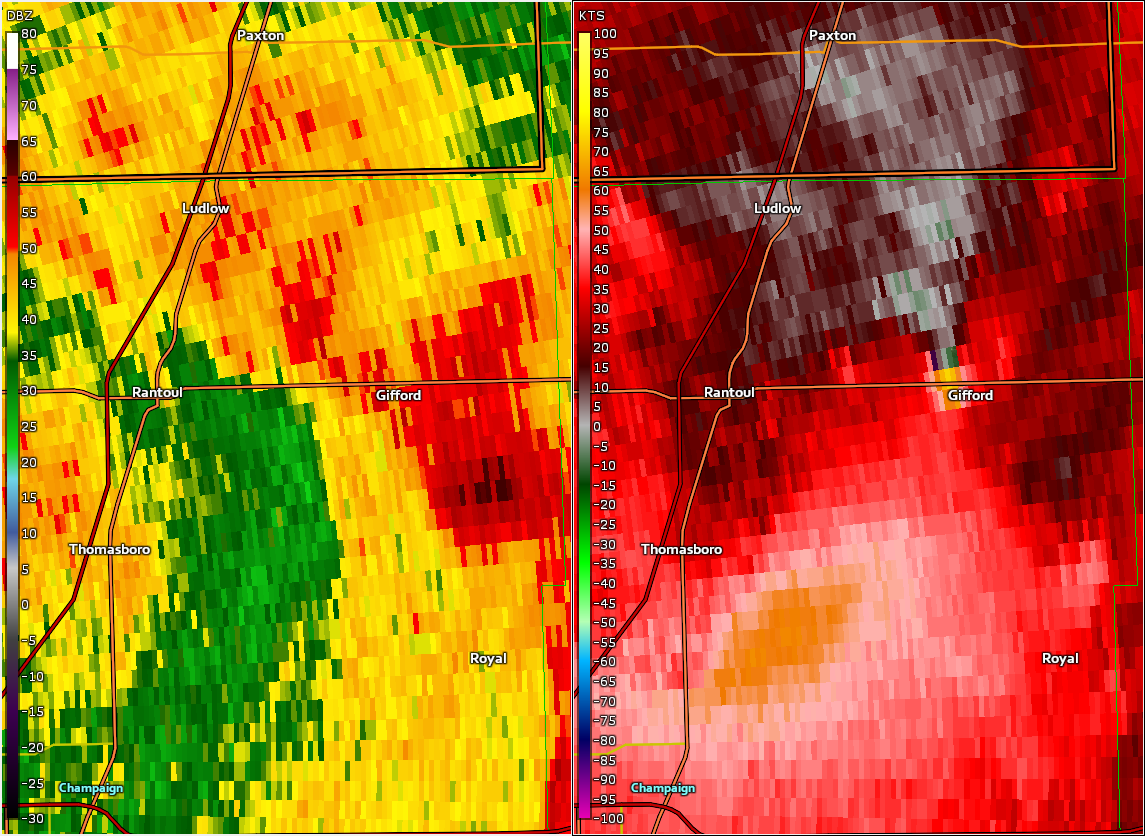 |
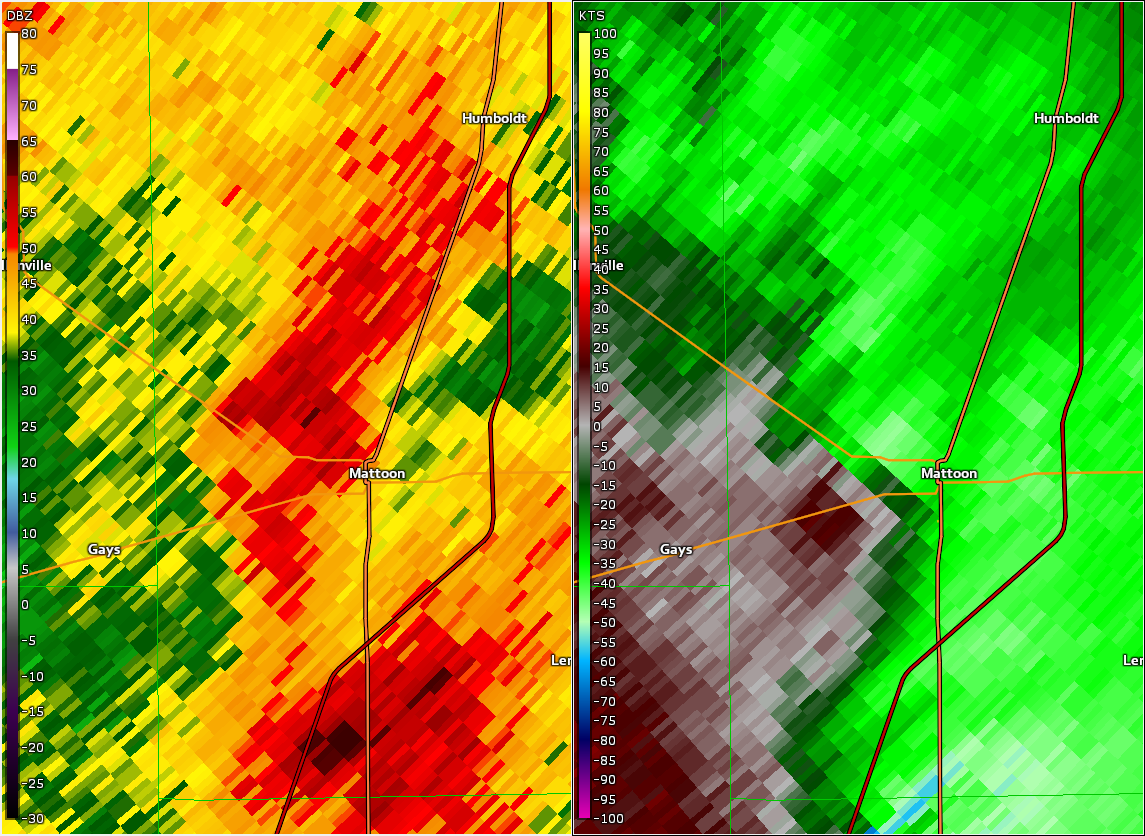 |
|
| Radar image near Lerna, IL at 12:13 AM CDT March 15 showing gate-to-gate rotation on storm relative velocity (upper right) co-located with a tornadic debris signature on correlation coefficient (lower left). | Reflectivity and storm relative velocity as the tornado passed through Gifford. Notice the enhanced velocity surge just northeast of Champaign. | Reflectivity and velocity showing broad rotation around the time of the brief tornado touchdown on the northwest side of Mattoon. Our radar was sampling ~5500 ft AGL, making it a challenge to know whether a tornado was in fact on the ground at the time. | Caption |
Additional Information
The Forecast
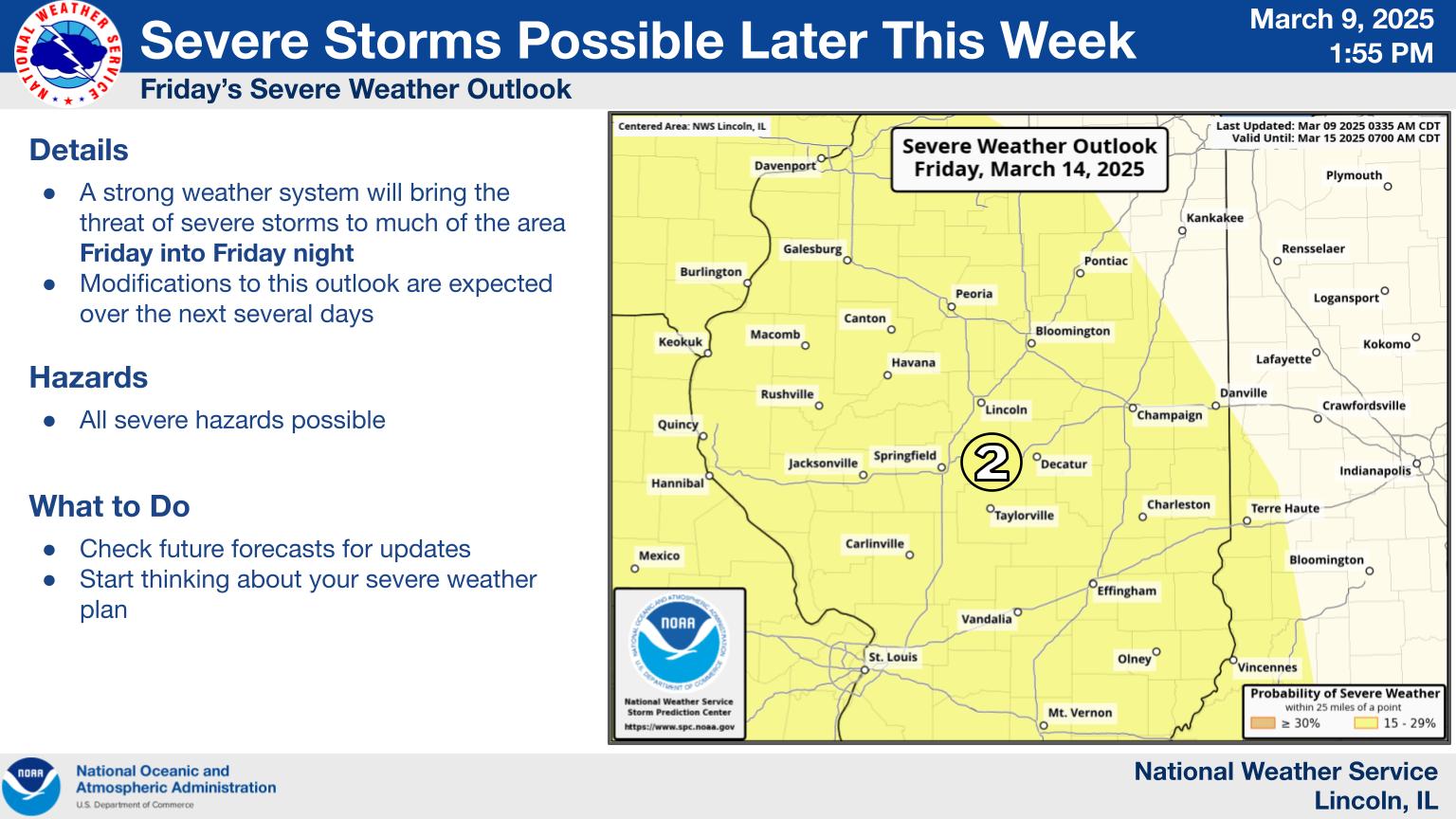 |
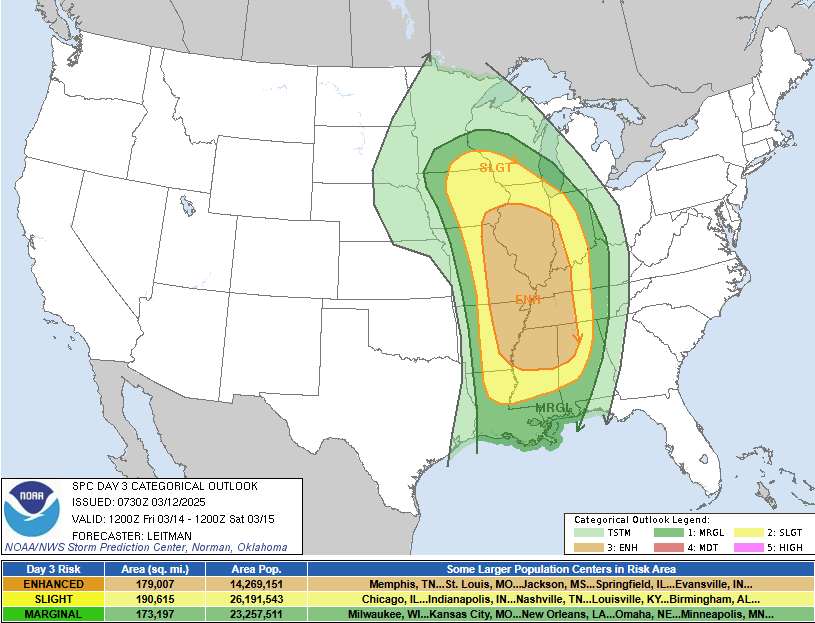 |
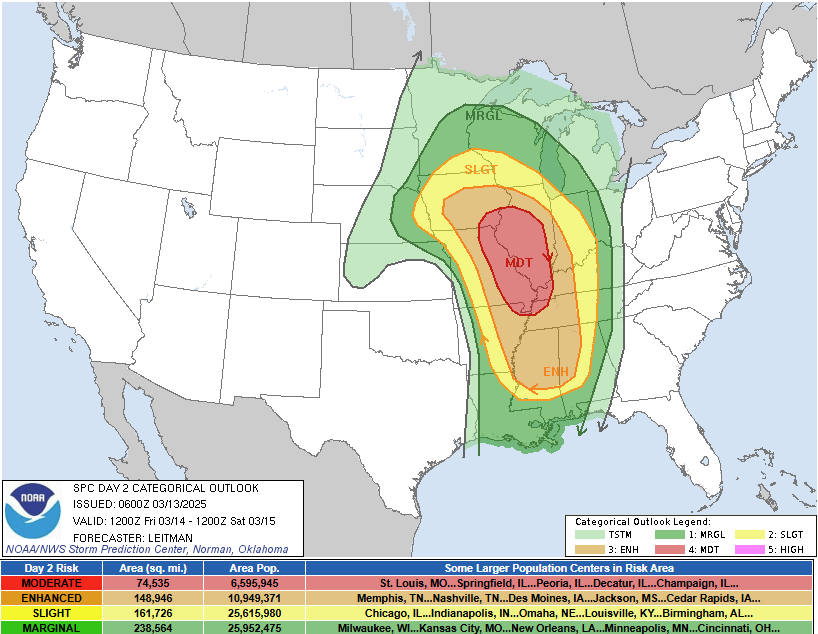 |
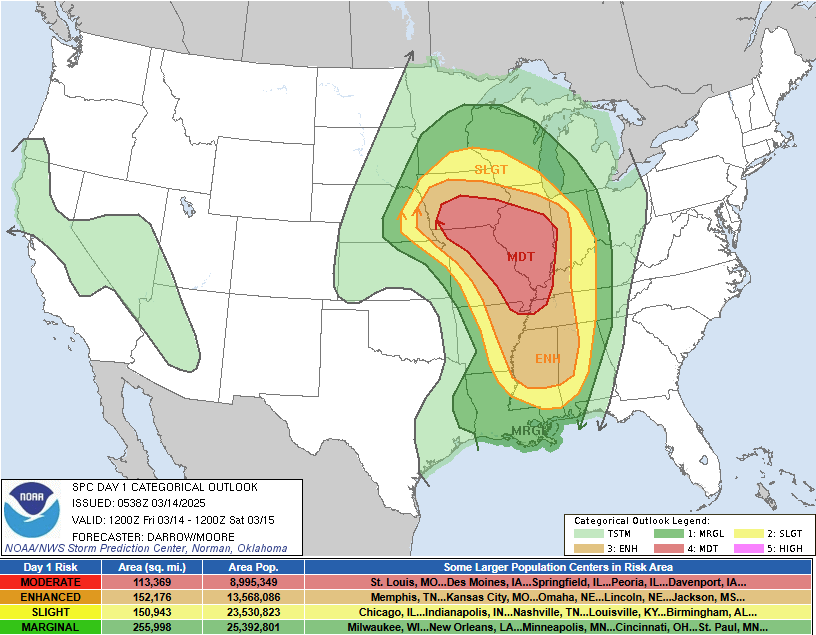 |
| Graphic showing the Storm Prediction Center's thunderstorm outlook 6 days ahead of the event. | SPC Day 3 Categorical Outlook issued March 12 at 0730Z. | SPC Day 2 Categorical Outlook issued March 13 at 0600Z. | SPC Day 1 Categorical Outlook issued March 14 at 1200Z. |
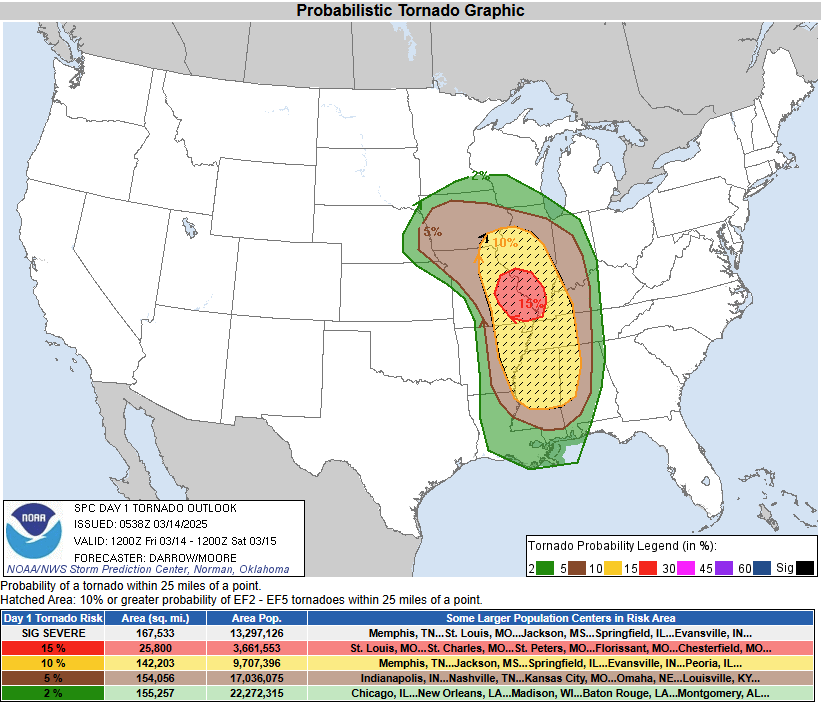 |
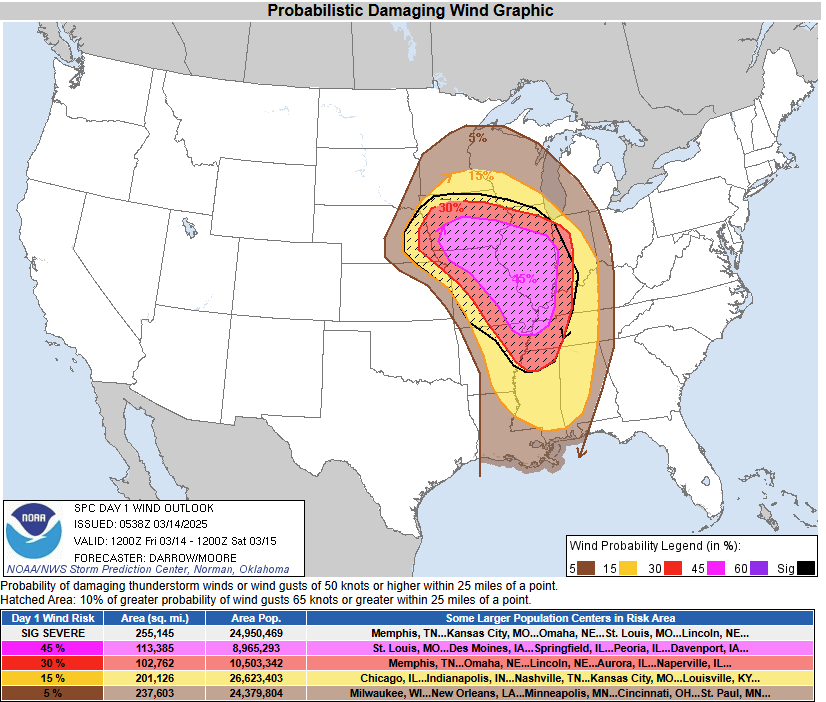 |
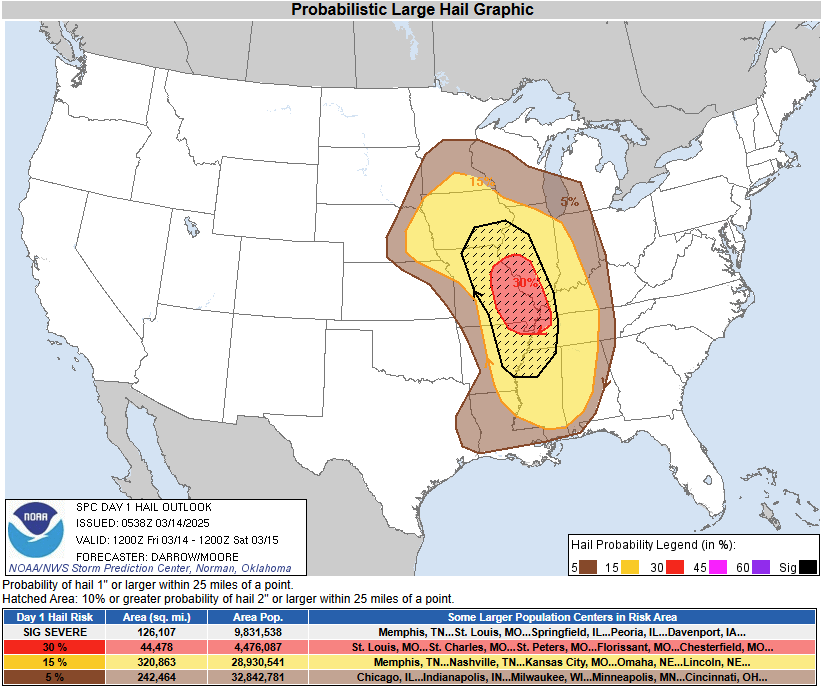 |
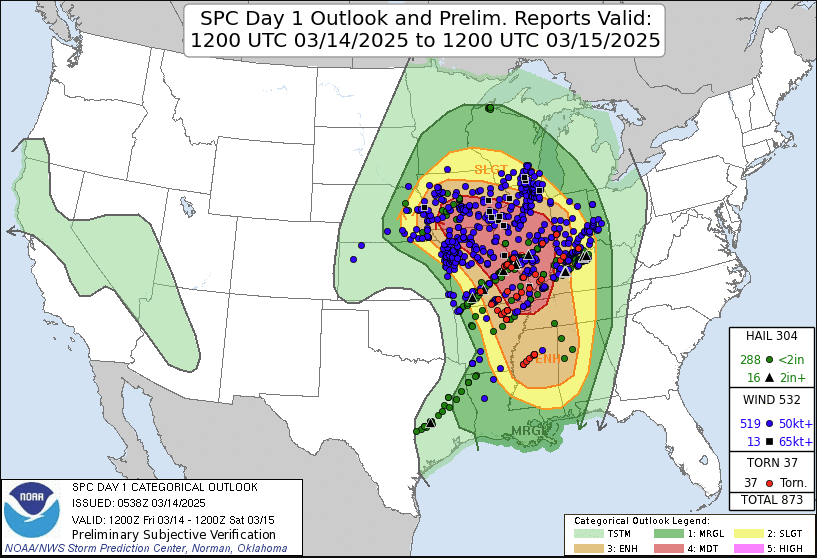 |
| SPC Day 1 Tornado Outlook issued March 12 at 1200Z. | SPC Day 1 Wind Outlook issued March 12 at 1200Z. | SPC Day 1 Hail Outlook issued March 12 at 1200Z. | SPC Day 1 Categorical Outlook with Storm Reports overlayed. |
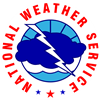 |
Media use of NWS Web News Stories is encouraged! Please acknowledge the NWS as the source of any news information accessed from this site. |
 |
US Dept of Commerce
National Oceanic and Atmospheric Administration
National Weather Service
Central Illinois
1362 State Route 10
Lincoln, IL 62656
217-732-7321 (forecast recording) or 217-732-3089
Comments? Questions? Please Contact Us.
Thank you for visiting a National Oceanic and Atmospheric Administration (NOAA) website. The link you have selected will take you to a non-U.S. Government website for additional information.
NOAA is not responsible for the content of any linked website not operated by NOAA. This link is provided solely for your information and convenience, and does not imply any endorsement by NOAA or the U.S. Department of Commerce of the linked website or any information, products, or services contained therein.
You will be redirected to:
























